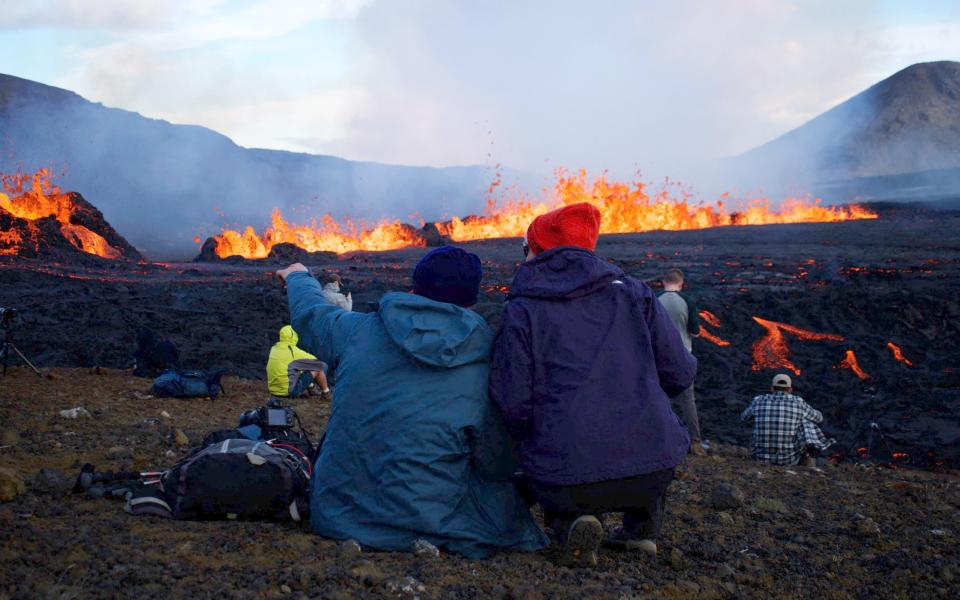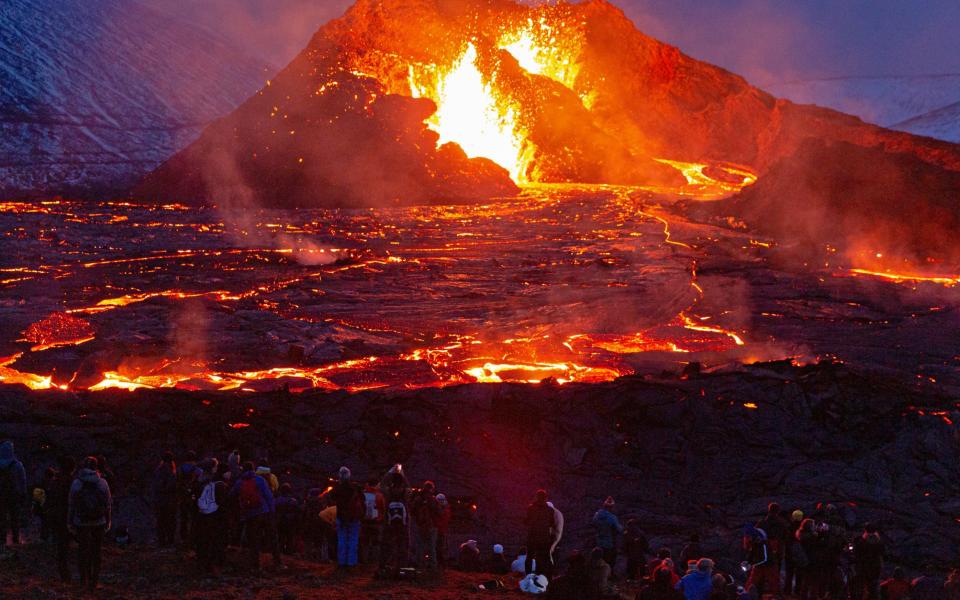Walking through a charred landscape, steam streaming from the horizon into a lifeless sky, I could have found myself in a dystopian nightmare. Darkness, rubble, sulphurous gases: not exactly the triumvirate of sun, sea and sand that determines most people’s holiday choices. But like thousands of eager tourists, I came here for a tantalizingly rare glimpse of the fire in Iceland’s belly.
Fagradalsfjall was silent for more than 6,000 years and was the first active volcano on the Reykjanes Peninsula in eight centuries. On March 19, 2021, a 600-foot-long fissure appeared in the ground and began spewing lava from two craters. Since then, activity in the area has been bubbling away.
Volcanic explosions usually signal an evacuation, but Fagradalsfjall was declared a “tourist eruption” and safe for the public to visit. Less than an hour’s drive from Keflavik International Airport, it has attracted more than 680,000 tourists so far, according to data collected by the Icelandic Tourist Board. Helicopters hovered above rivers of molten magma and hikers in gas masks lined the hills in the dark to witness electrical nighttime displays.
So it’s not surprising that signs before Christmas that another eruption might occur on the peninsula sent ripples of seismic excitement beyond the Richter scale. “Book your flights now so you can witness the creation of the earth!” wrote former Icelandic President Ólafur Ragnar Grímsson on X, formerly Twitter. But this time the earth was not so receptive. Houses have been flooded by lava and the threat to human life is very real.
“I think this is the beginning of an unknown future – five outbursts in four years,” Asa Steinars, a content creator, wrote on her Instagram broadcast channel. Clearly this is no longer a ‘tourist blowout’. But it does raise the question: what is that?
Even when Fagradalsfjall was open, there were concerns about safety and independent travelers not obeying the authorities’ rules and guidelines. Images circulate on social media showed onlookers almost bathing in a shower of hot stones, and Steinars posted her own warning to followers: “People are becoming increasingly [sic] close to this thing. I’ve seen craters like this break, followed by a waterfall.”
I too witnessed idiotic kamikaze behavior. People raced over steaming lava vents with drones to fill their social media feeds. It was ridiculous.
More and more people are willing to take greater and greater risks. And not just in Iceland.
There are currently more than 1,500 active volcanoes in 81 countries and about 60 erupt every year. Lava hunters can track the latest eruptions on a Global Volcanism Program website, set up by the Smithsonian Museum of Natural History. Volcano tours are regularly included in holiday packages, tourist board marketing campaigns and cruise ship itineraries.
Ten years ago, as part of a trip to New Zealand, I visited Whakaari (also known as White Island), a cloud of smoke rising from the ocean. When we disembarked at the base of the crater, we were given gas masks and led through a toxic mosaic of swirling sulphurous colors. It was beautiful and exciting, but I was relieved to leave. When I asked if it was safe, a guide assured me that the scientists responsible knew what was going on. But even science can be confused by nature. Tragically, an eruption in 2019 killed 22 people, and the site has since closed.


So what draws us to these potentially dangerous places?
The thin line between passion and madness was explored in the National Geographic documentary Fire of Love, the story of French volcanologist couple Katia and Maurice Krafft who dedicated their lives to better understanding volcanoes and had bizarre dreams about kayaking down a lava flow.
Not everyone is that extreme, but many of us share a fascination with the power of nature.
“[Volcanoes] are primary and ultimately nature at its purest and rawest,” says Georgina Hancock, marketing director of tour operator Discover The World, which offers a ‘volcano hotline’ that alerts guests to possible trips to see eruptions as they happen. “Even when a volcano stops erupting and there is no more molten lava, our customers are still intrigued to see the newly changed landscape. The ability of Icelanders to live and thrive on this ever-evolving island arouses a deep fascination for visitors.”
One of Europe’s highest active volcanoes, Mount Etna, lures visitors with its “magnetic force,” according to Alberto Ciarallo, the founder of Sicily travel specialist Cognoscenti Travel. “It has a special energy and presence,” he says. “Volcanoes take travelers back to a prehistoric era.”
His routes range from hiking with a volcanologist to an e-bike tour through the forested foothills. “A healthy respect for the environment is absolutely essential,” Ciarallo emphasizes. “I work with expert guides and volcanologists who are trained to ‘read’ conditions before planning an excursion and always err on the side of caution.”


When done properly, responsible volcano tourism can be much safer than many other outdoor adventure activities. “Can skiing be safe? Can paragliding be safe? Can driving be safe? Strictly speaking, nothing is safe,” says Dr. Tom Pfeiffer, a geologist and volcanologist who organizes special excursions to view volcanoes through his company Volcano Adventures.
Joining an organized tour is undoubtedly the safest way to view and enjoy a live volcanic event. Discover the World insists that their customers only visit locations with a qualified guide and are unlikely to offer trips to the latest eruption. Using a licensed operator is also essential for insurance coverage.
“There is no specific exclusion around cover for volcano tourism travel or participation in volcano tours, but cover may be void if travelers fail to exercise reasonable care or behave in a way that could endanger their own safety or property ” says Jonathan Frankham, the managing director for UK and Europe at travel insurance company World Nomads. “It is important to follow official advice or warnings against travel.”
Granted, part of a volcano’s appeal is its volatile nature and unpredictability. Every time I’ve crunched over lava fields or trekked along the slopes of a crater, I’ve always been humbled and – if I’m honest – a little scared. But a little fear is healthy; it is a recognition of the power of nature, of which respect is an integral part. We all need to be aware of our human limits and know when it’s time to step back – otherwise we risk paying a price that many have paid before.